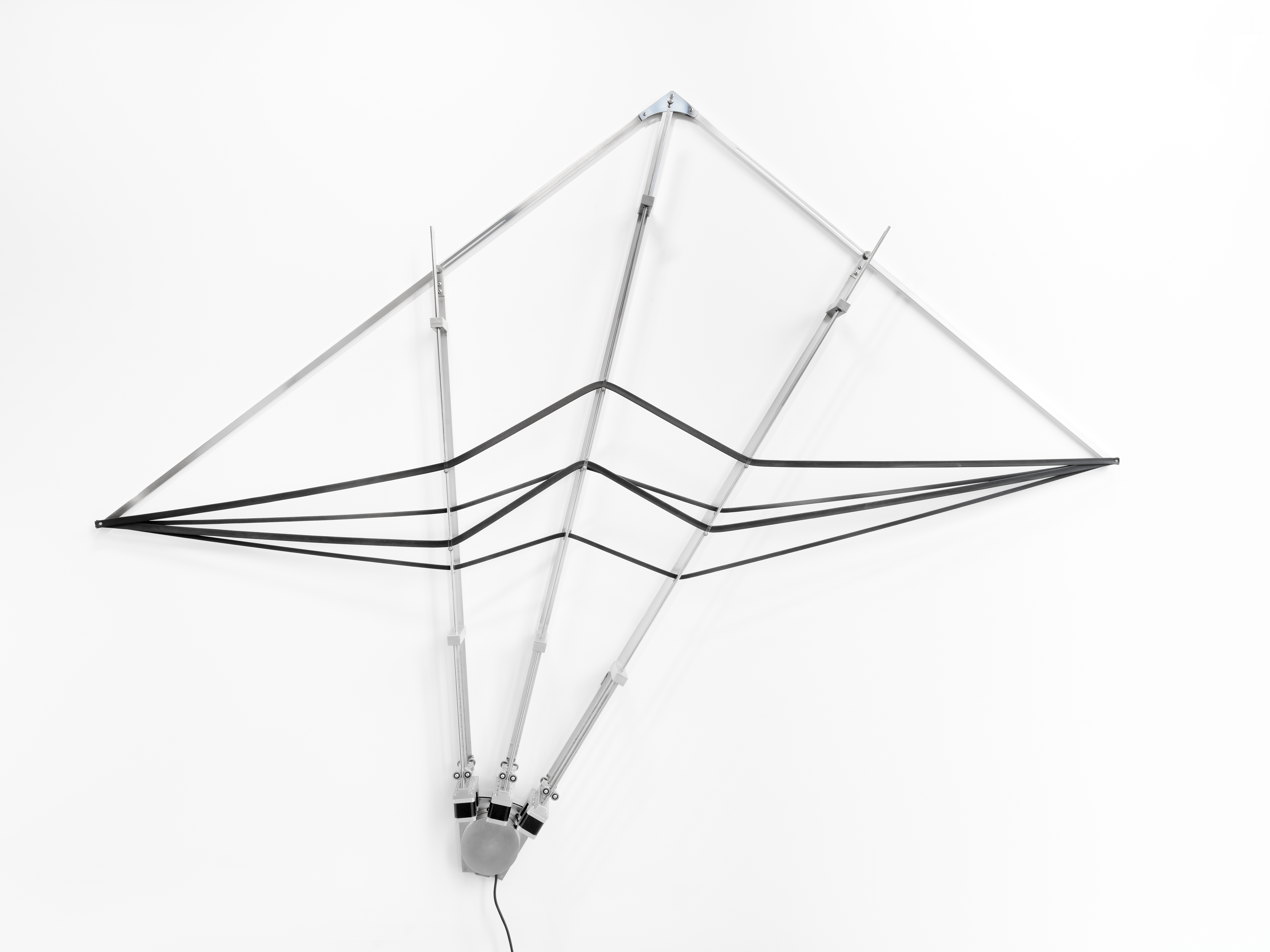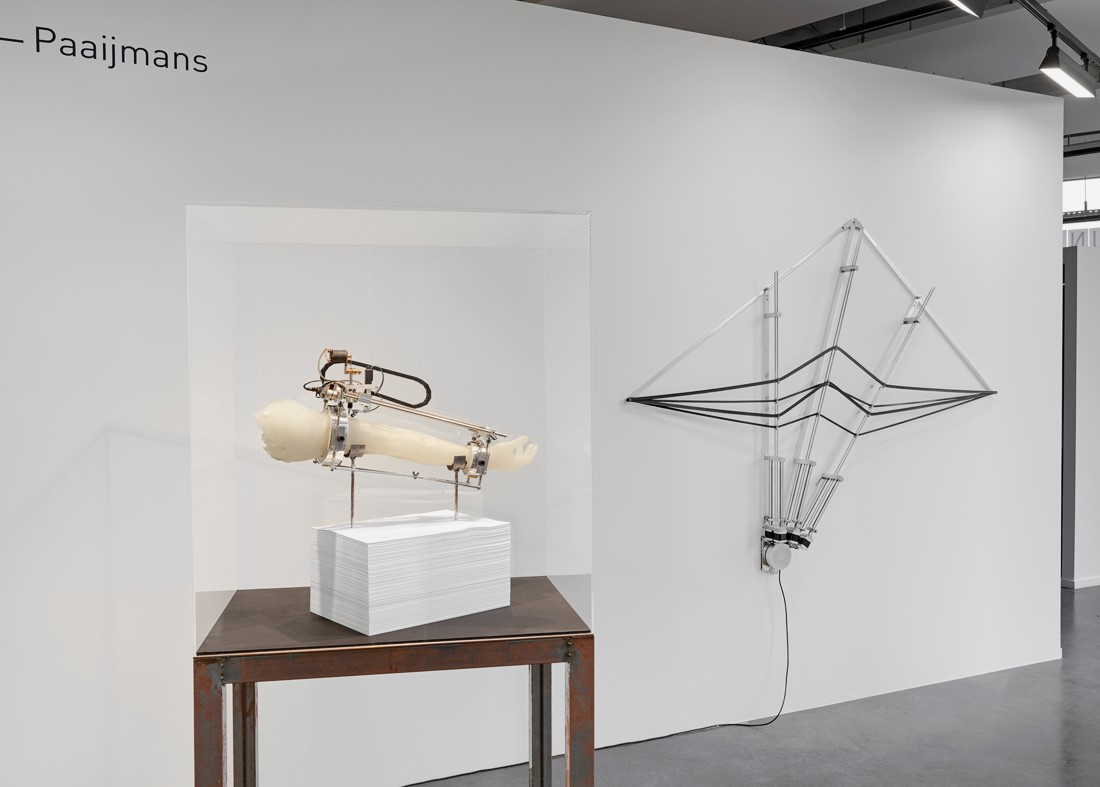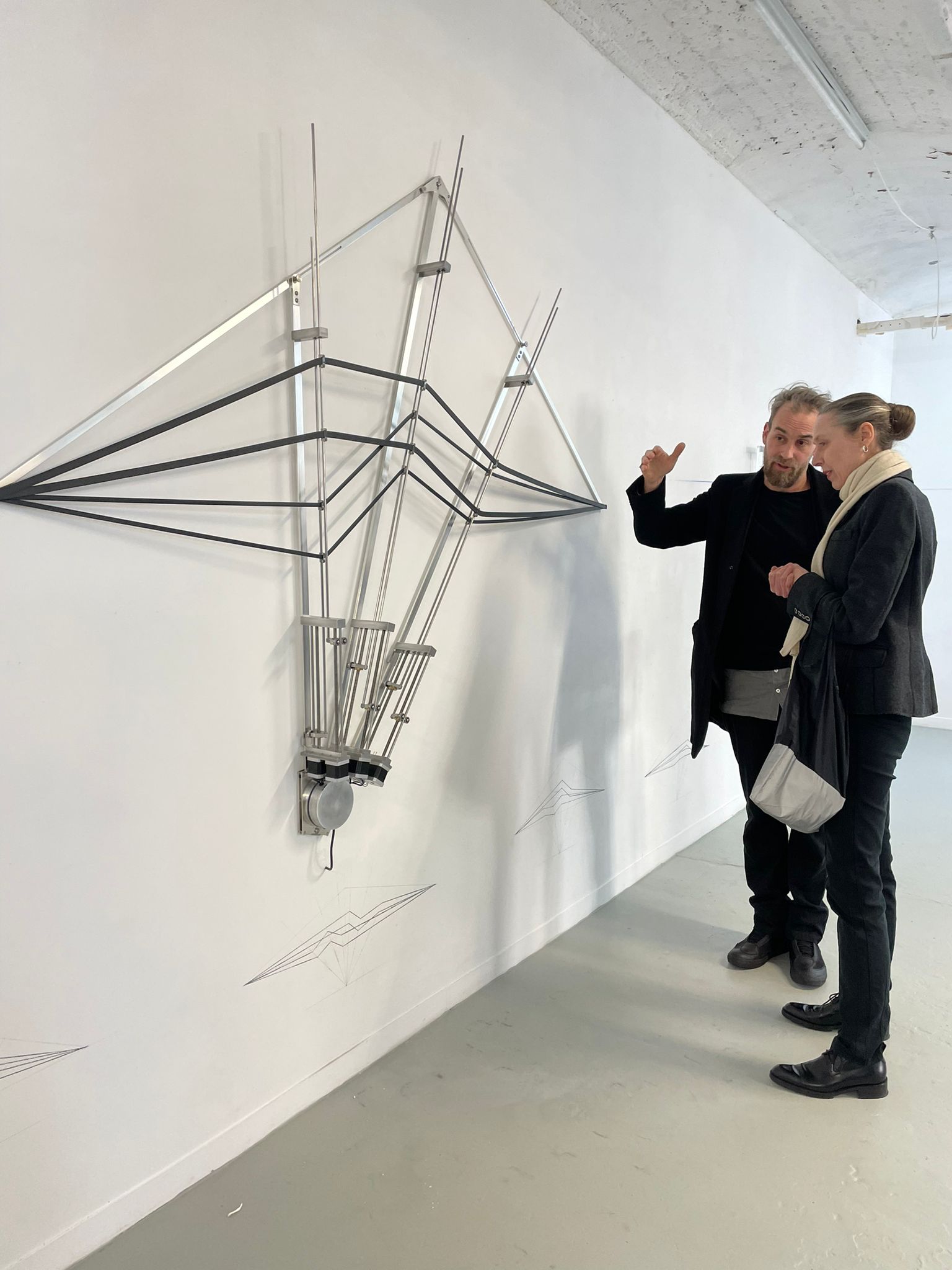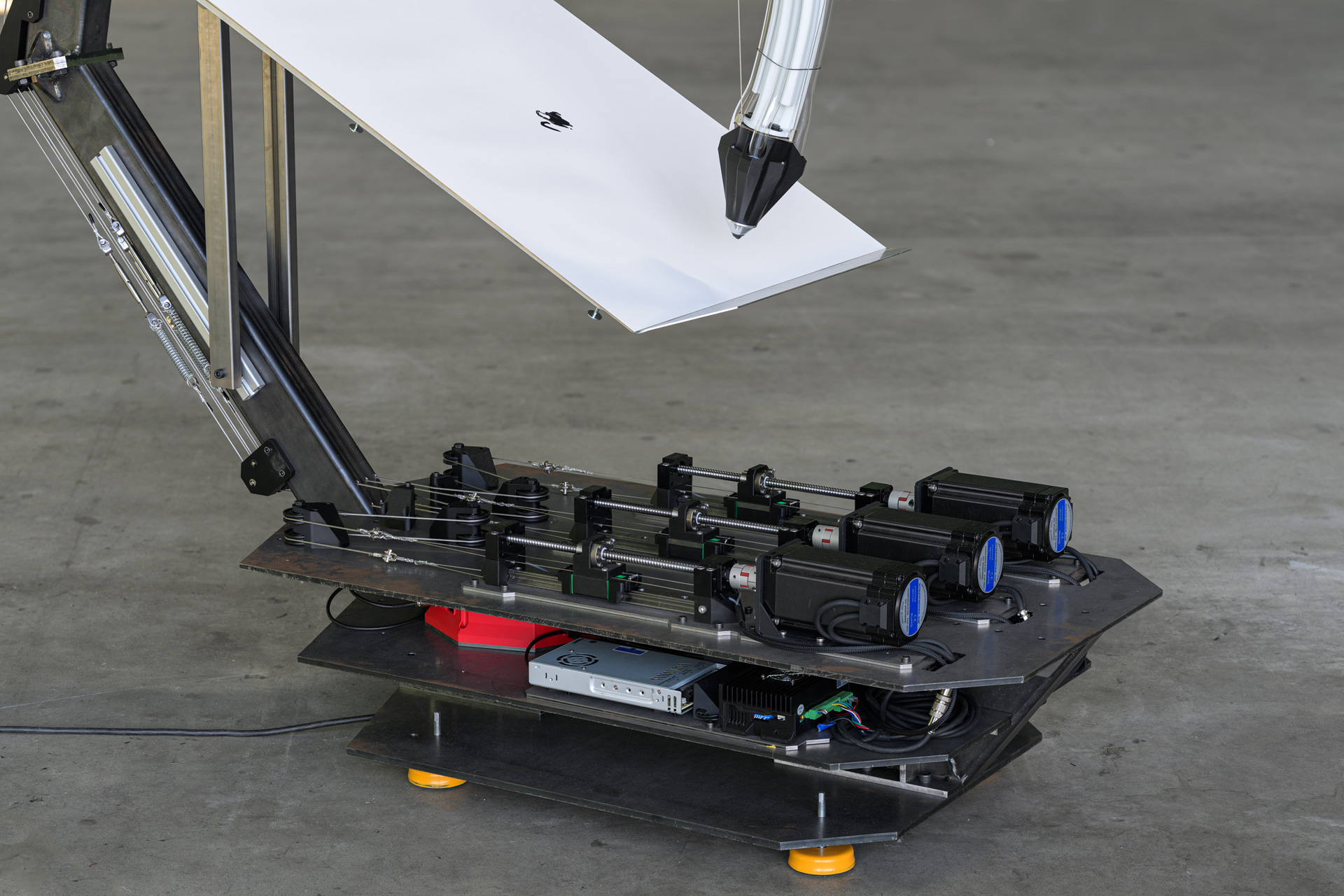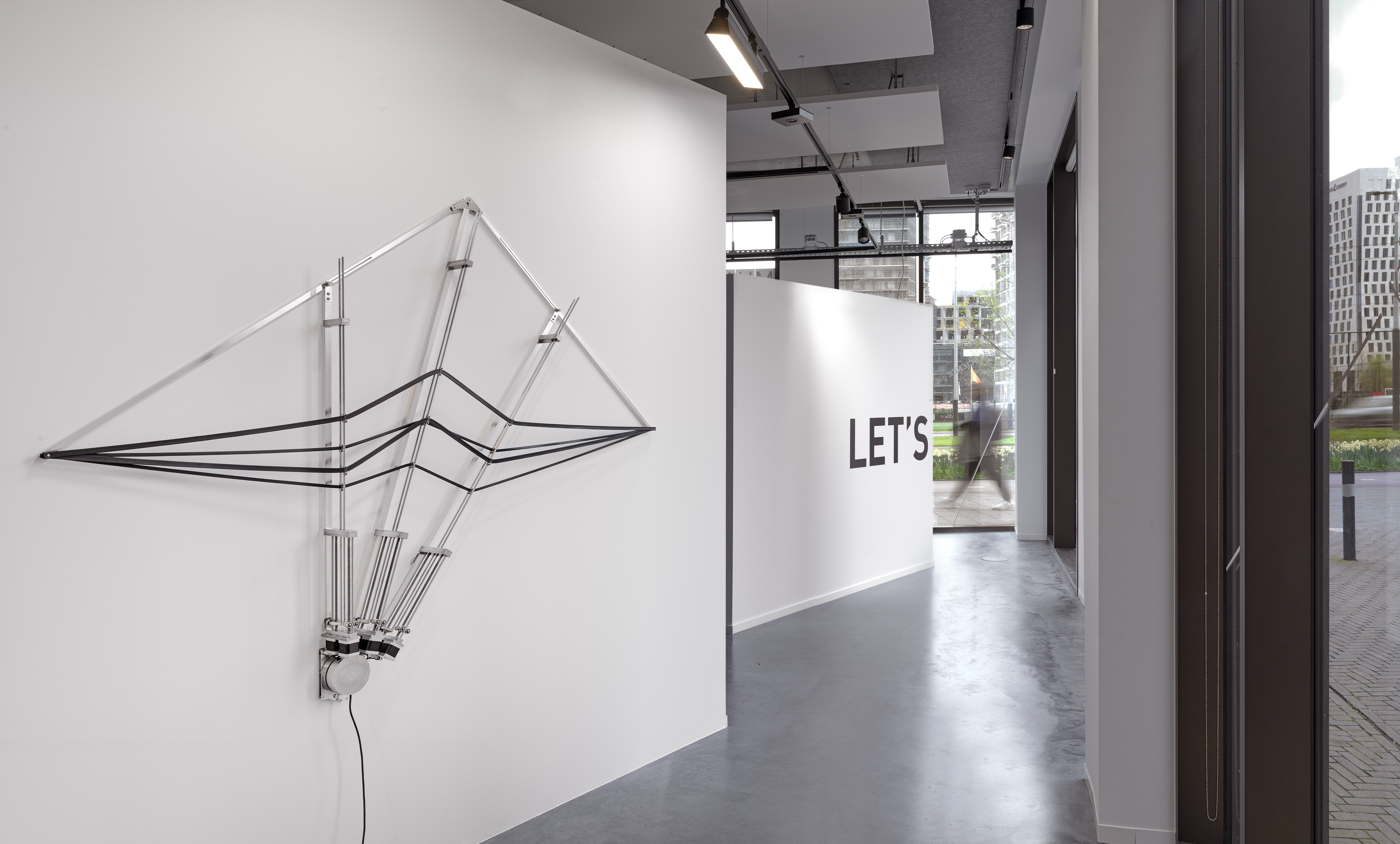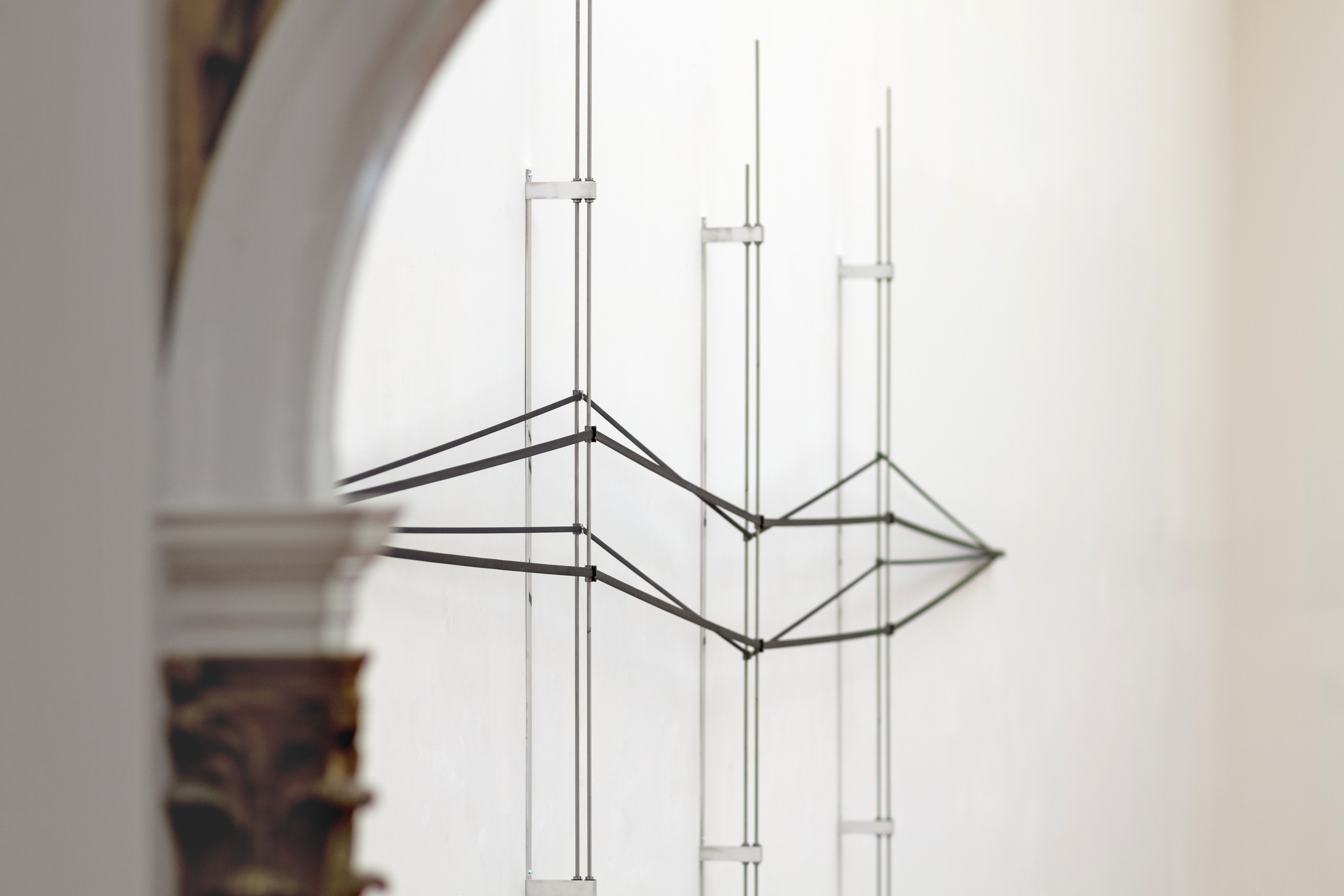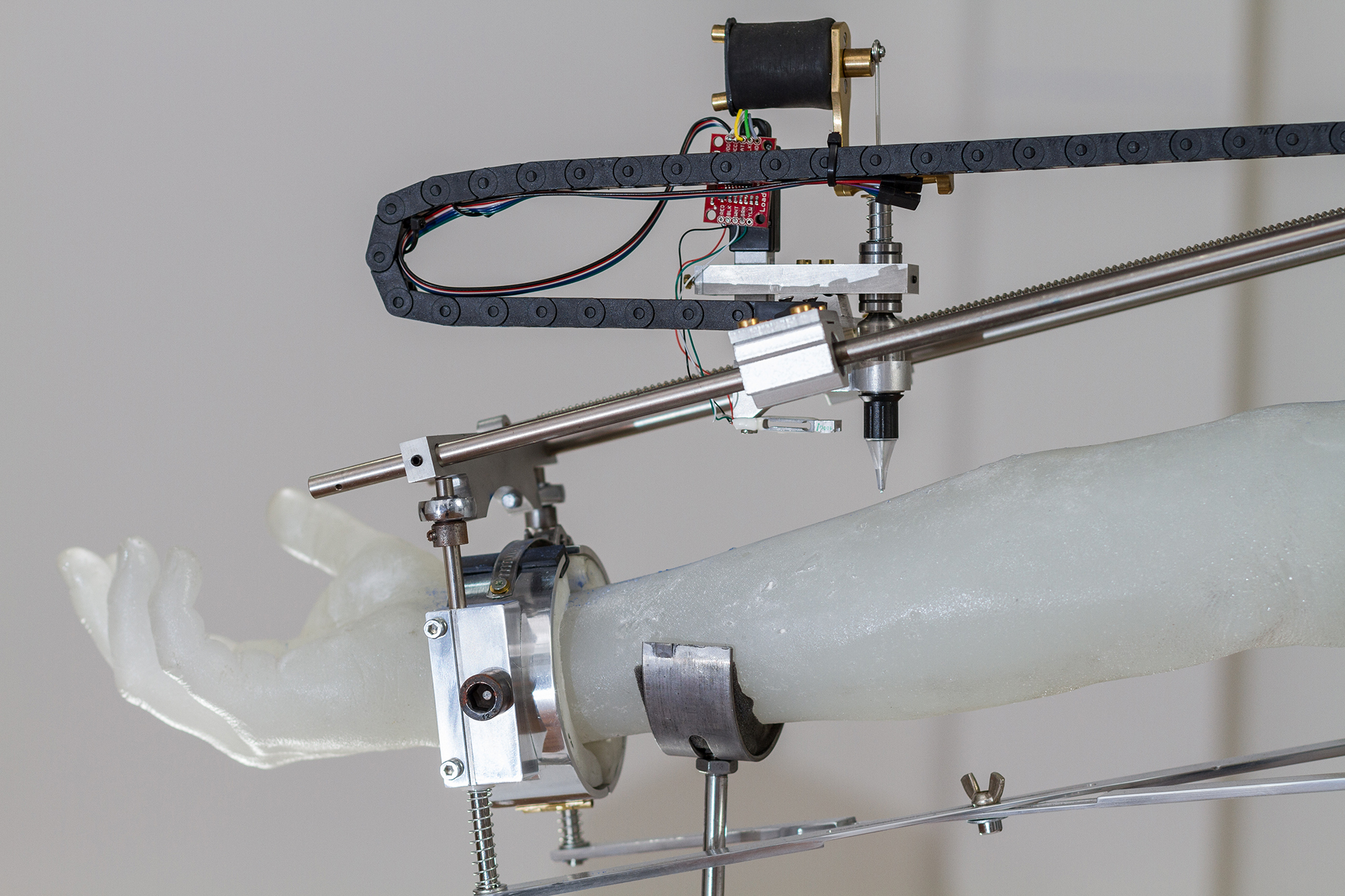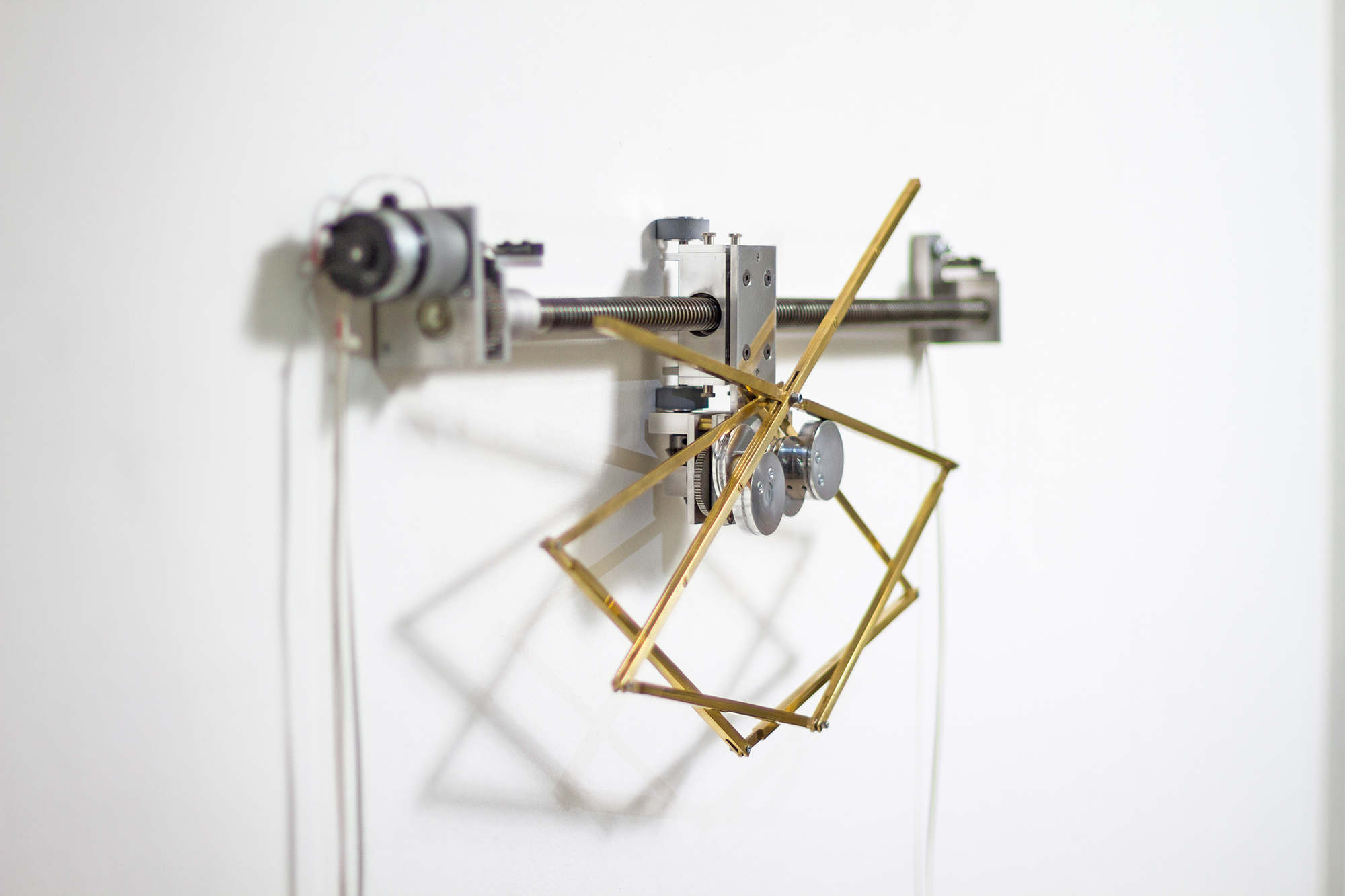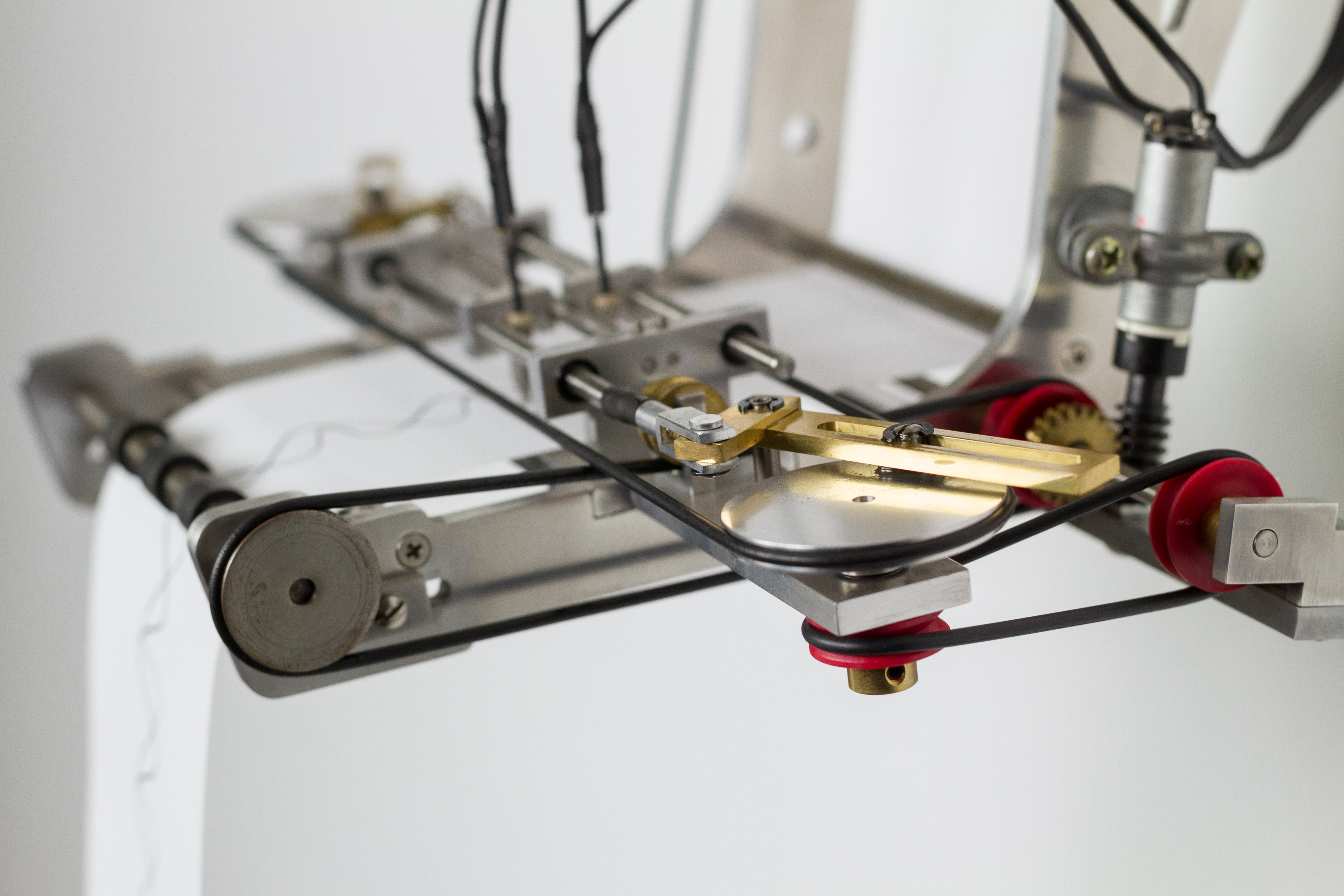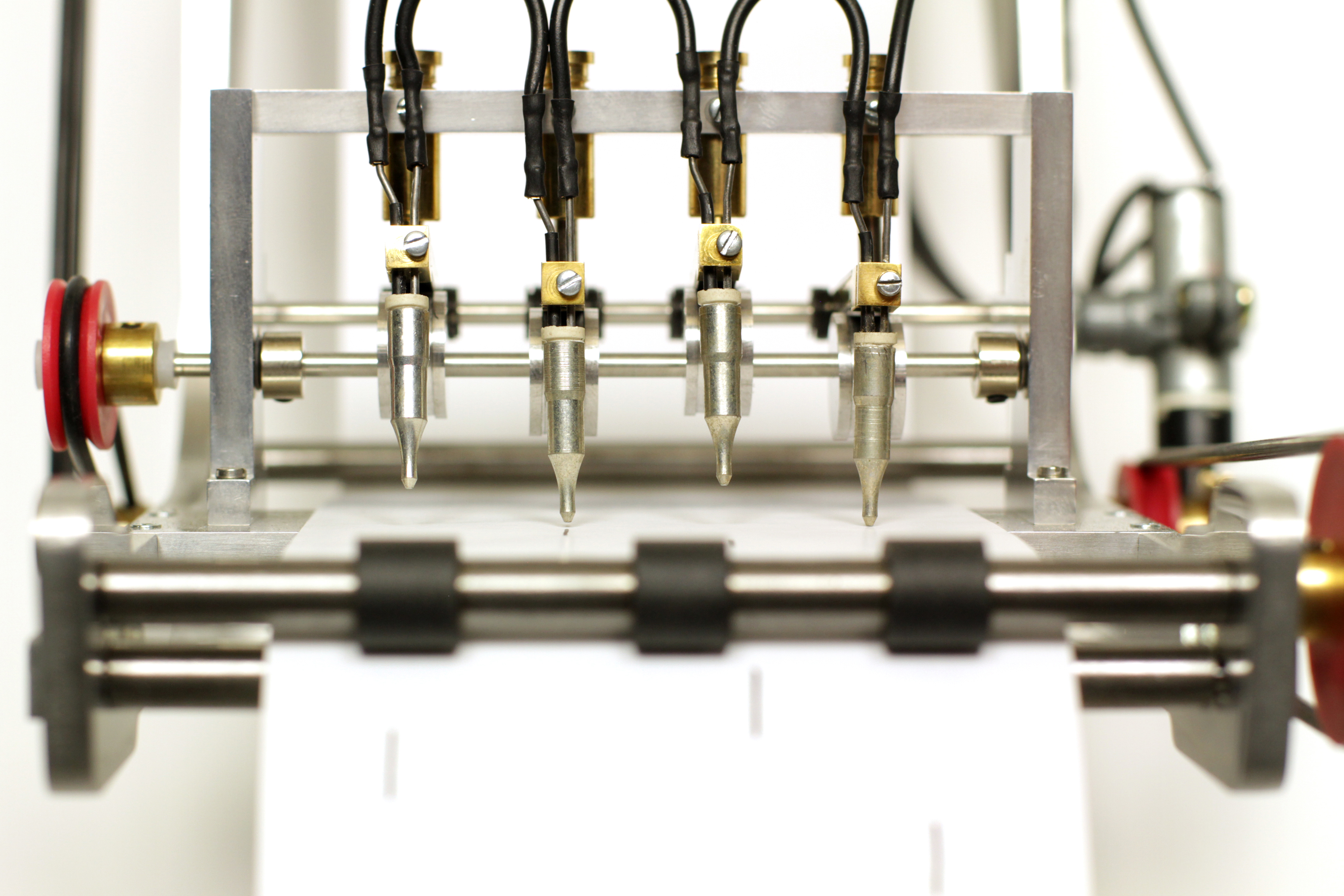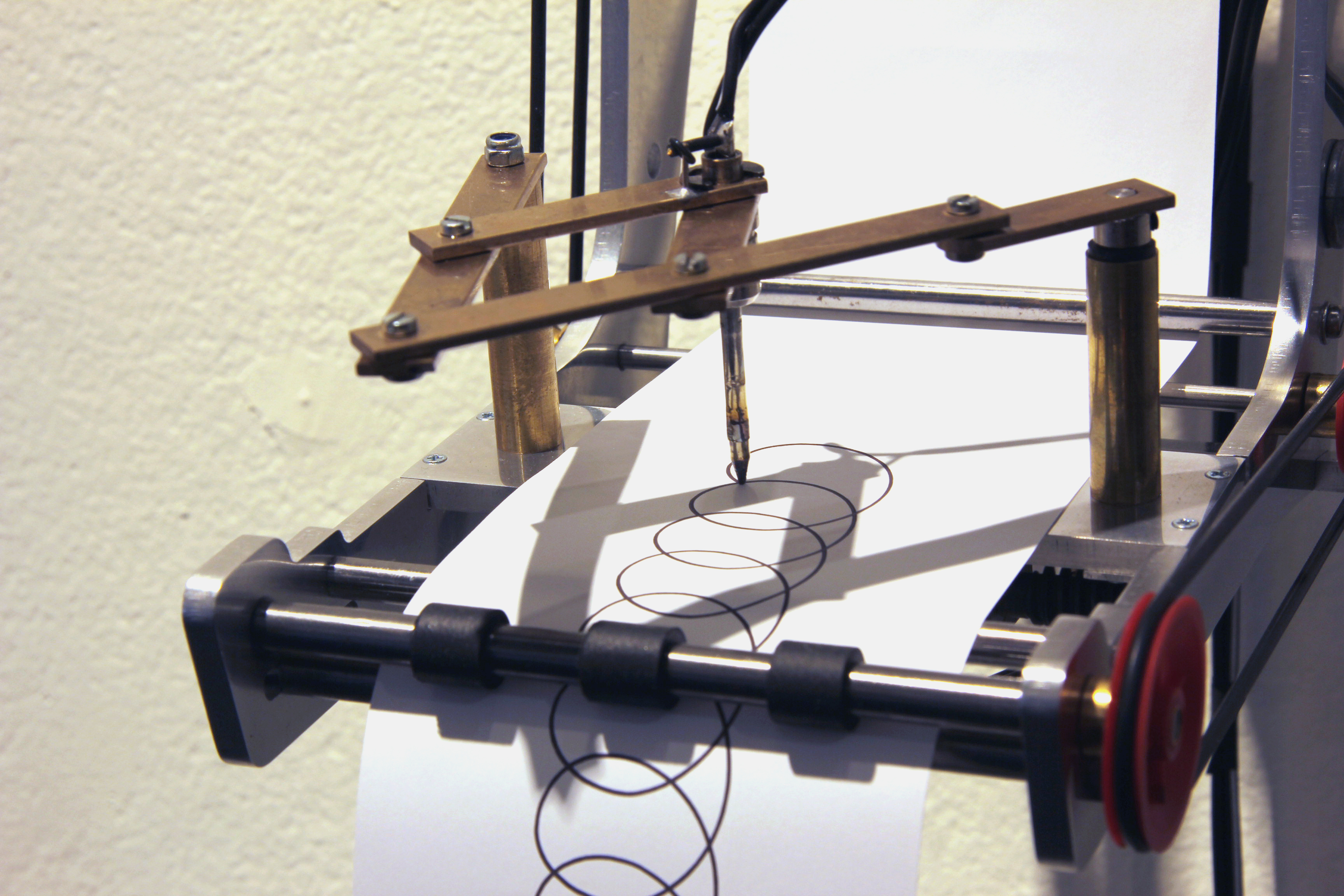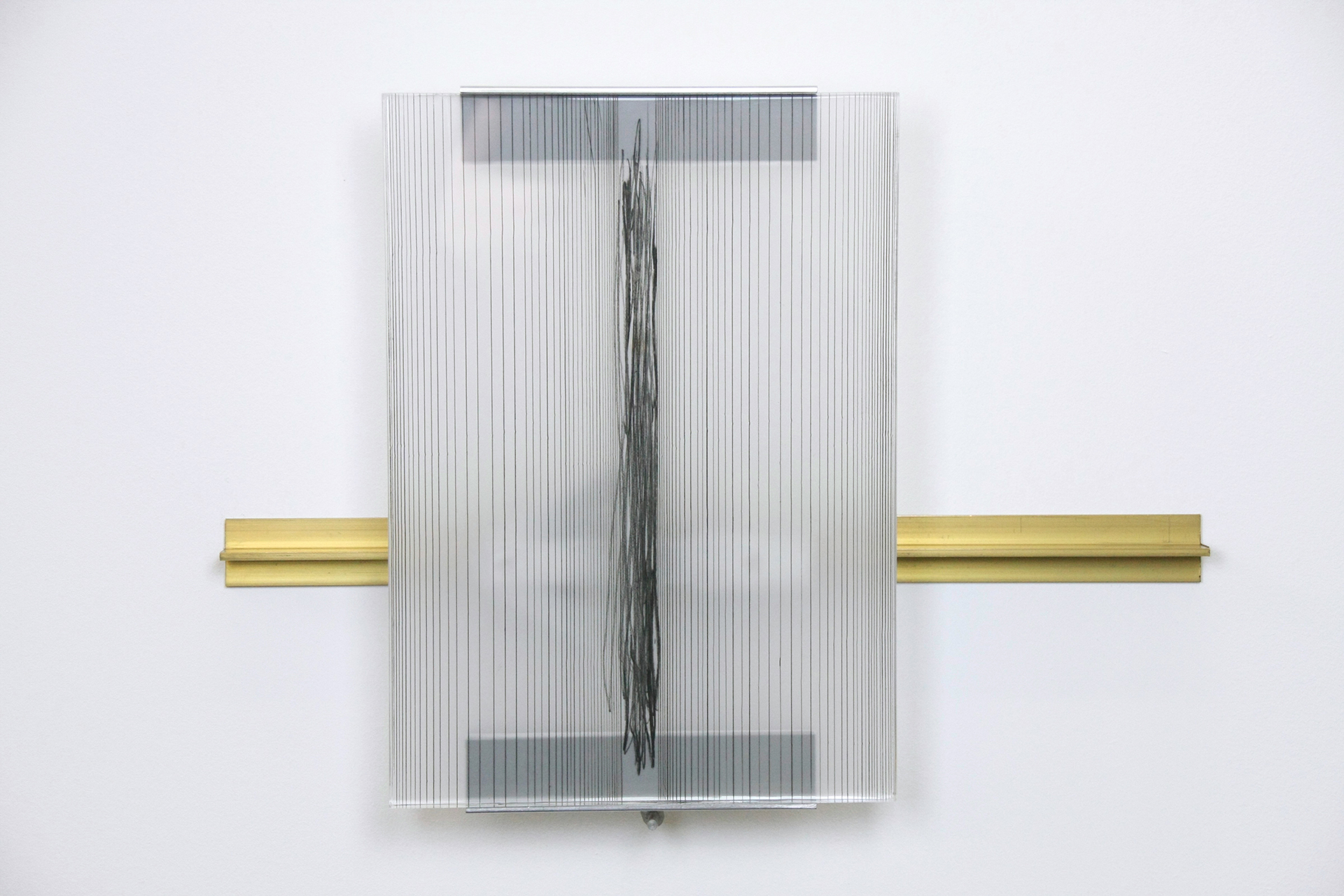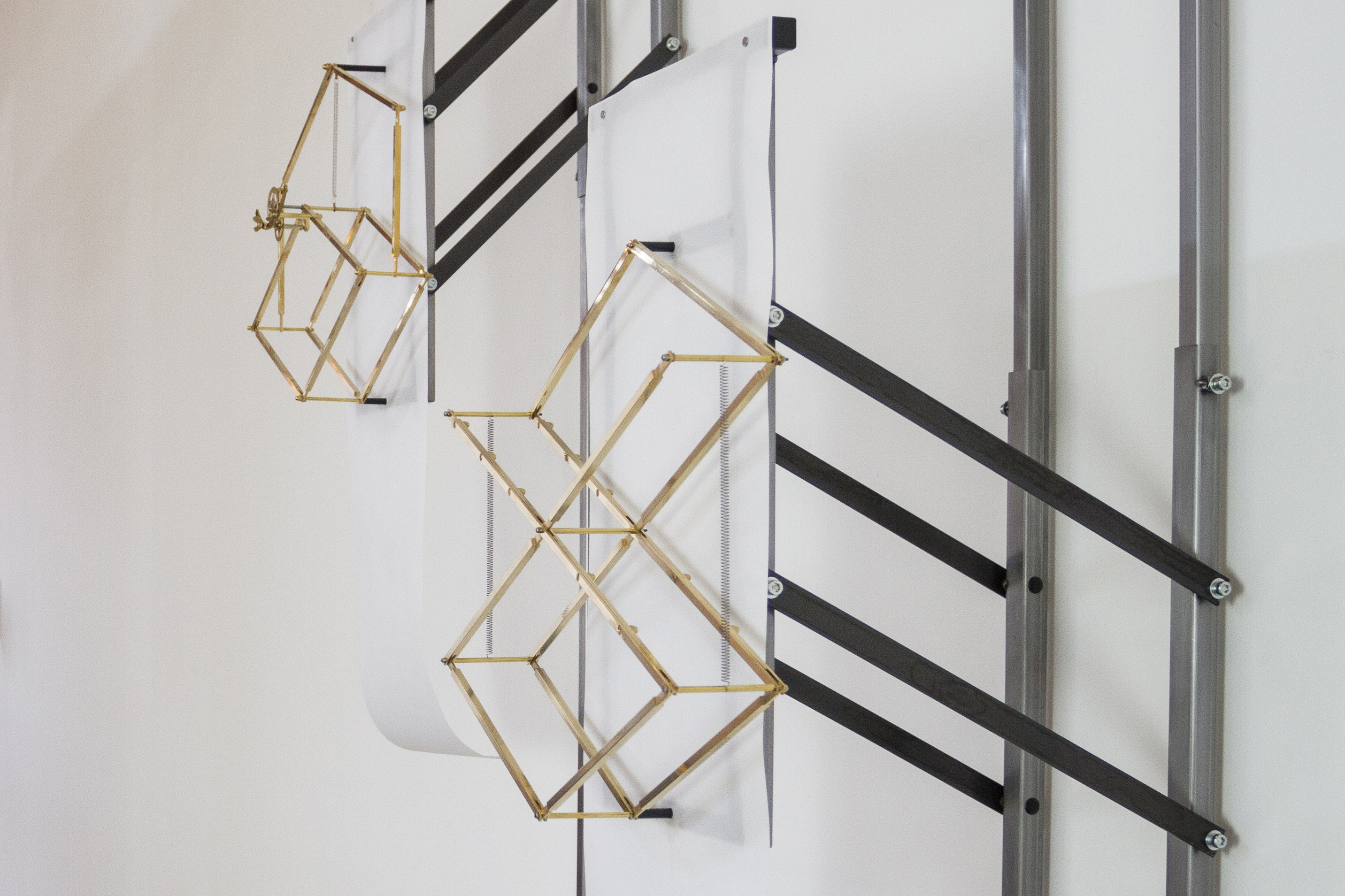Jorrit Paaijmans
Hyperdrawing
‘However, there is another drawing that emerges in the absence of any antecedent stimulus or provocation; which does not follow, but is initiated instead in the hope of making manifest that which could not have been conceived of at the outset nor planned for in advance. In doing and being so, this drawing draws rather than is drawn. It no longer draws on - by making a demand on - the observable world nor on the powers of the imaginary.’
Emma Cocker, The restless line, in: Hyperdrawing, p. xiii, 2012
Drawing is often described as an expressive art form that exposes the hand of the artist unmediated. By contrast, Jorrit Paaijmans [NL] is not interested in showing anything personal in his drawings. In his search towards a more objective manner of drawing, he has gradually erased his own artist’s hand from the drawing process entirely.
Paaijmans’ work is best described as an in-depth exploration of the drawing discipline in the broadest sense of the word. His aim for an objective, formally abstract way of drawing urged him to radically move away from traditional drawing materials and techniques. He started to make drawings on paper with makeshift tools such as a syringe [Algorythm#01, 2009], which over time developed into proper instruments like a semi-automatic pendulum installation [Prototype#02, 2009] and also experimented with drawing in a performative setting [Prototype#03, 2010]. In his explorations, Paaijmans’ focus shifted from the result - the drawing itself - to the process of drawing. While investigating the act of making a drawing and dissecting this process, Paaijmans deconstructs drawing itself to its basic elements.
Paaijmans expresses with his series of work Automatic Signum [2013-2015] that a drawing is essentially a registration of movement in time. A dot is created with a single movement in a single moment; the length of a line reflects the duration of the contact between pen and paper; the articulation of the line indicates how much pressure has been applied, or what the thickness or the angle of the pen has been; a pattern reflects the repetition of movement over a certain length of time. Automatic Signum consists of five drawing devices, Linear, Punctatum, Circular, Quattor Punctatum and Curvarum Linearum. With these fully automated mechanical sculptures, Paaijmans radically replaced the movement of his human drawing hand with mechanics. Each device explores a different basic formal aspect of drawing: dot, line or plane. Paaijmans taught himself to engineer and manufacture these intricate mechanical devices, employing technology as a means to understand the essence of the discipline.
Paaijmans’ work is best described as an in-depth exploration of the drawing discipline in the broadest sense of the word. His aim for an objective, formally abstract way of drawing urged him to radically move away from traditional drawing materials and techniques. He started to make drawings on paper with makeshift tools such as a syringe [Algorythm#01, 2009], which over time developed into proper instruments like a semi-automatic pendulum installation [Prototype#02, 2009] and also experimented with drawing in a performative setting [Prototype#03, 2010]. In his explorations, Paaijmans’ focus shifted from the result - the drawing itself - to the process of drawing. While investigating the act of making a drawing and dissecting this process, Paaijmans deconstructs drawing itself to its basic elements.
Paaijmans expresses with his series of work Automatic Signum [2013-2015] that a drawing is essentially a registration of movement in time. A dot is created with a single movement in a single moment; the length of a line reflects the duration of the contact between pen and paper; the articulation of the line indicates how much pressure has been applied, or what the thickness or the angle of the pen has been; a pattern reflects the repetition of movement over a certain length of time. Automatic Signum consists of five drawing devices, Linear, Punctatum, Circular, Quattor Punctatum and Curvarum Linearum. With these fully automated mechanical sculptures, Paaijmans radically replaced the movement of his human drawing hand with mechanics. Each device explores a different basic formal aspect of drawing: dot, line or plane. Paaijmans taught himself to engineer and manufacture these intricate mechanical devices, employing technology as a means to understand the essence of the discipline.
With his recent works Rhombi movens [2015] and Linearis Objectum [2016] Paaijmans focusses on the drawing line, deploying it as an autonomous object. These installations both play with the eye of the beholder, using composition, linear perspective and shadow to create abstract patterns of line arrangements. With these works he has further developed the scale of his work from sculpture to installation.
Although his recent works take the shape of mechanical sculptures, Paaijmans still has the mind and eye of a draughtsman. Drawing has always been both the topic of his research and at the same time the tool he uses to investigate it. Paaijmans uses the term hyperdrawing1 to describe his practice, indicating his inclusive perspective on drawing: to identify drawing as a medium that stretches across any and all material approaches, a medium that originates from, but is no longer defined or restricted by the trinity of hand, drawing material and paper. As such, hyperdrawing indicates Paaijmans’ point of departure as much as his ambition. While exploring the artistic possibilities of mechanics, he questions and in doing so, actually changes the definition of what drawing is or can be. Ultimately it is his intention to provoke the viewer to question the essence of drawing and the possibilities of the discipline.
1 Hyperdrawing: Beyond the lines of contemporary art, edited by Sawdon, P. Marshall, R., 2012, Loughborough University.
Written by Arda van Tiggelen, commissioned by Jorrit Paaijmans, Januari 2017.
Although his recent works take the shape of mechanical sculptures, Paaijmans still has the mind and eye of a draughtsman. Drawing has always been both the topic of his research and at the same time the tool he uses to investigate it. Paaijmans uses the term hyperdrawing1 to describe his practice, indicating his inclusive perspective on drawing: to identify drawing as a medium that stretches across any and all material approaches, a medium that originates from, but is no longer defined or restricted by the trinity of hand, drawing material and paper. As such, hyperdrawing indicates Paaijmans’ point of departure as much as his ambition. While exploring the artistic possibilities of mechanics, he questions and in doing so, actually changes the definition of what drawing is or can be. Ultimately it is his intention to provoke the viewer to question the essence of drawing and the possibilities of the discipline.
1 Hyperdrawing: Beyond the lines of contemporary art, edited by Sawdon, P. Marshall, R., 2012, Loughborough University.
Written by Arda van Tiggelen, commissioned by Jorrit Paaijmans, Januari 2017.
Writings (selection)
[NL/ENG] Traces 2.0 Sanneke Huisman, curator/writer, May 2020
[NL/ENG] The drawing from then Sven Schlijper-Karssenberg, artcollector, April 2020
[NL/ENG] Drawing between man and machine Sanneke Huisman, curator/writer, October 2019
[NL] Out of the day Arno Kramer, artist/curator, Oktober 2019
Homo signans | Robotic drawing installation (presented below 1 of the 3 Homo signans robots) | porcelain-metal-mechanics-electronics-software | 2025


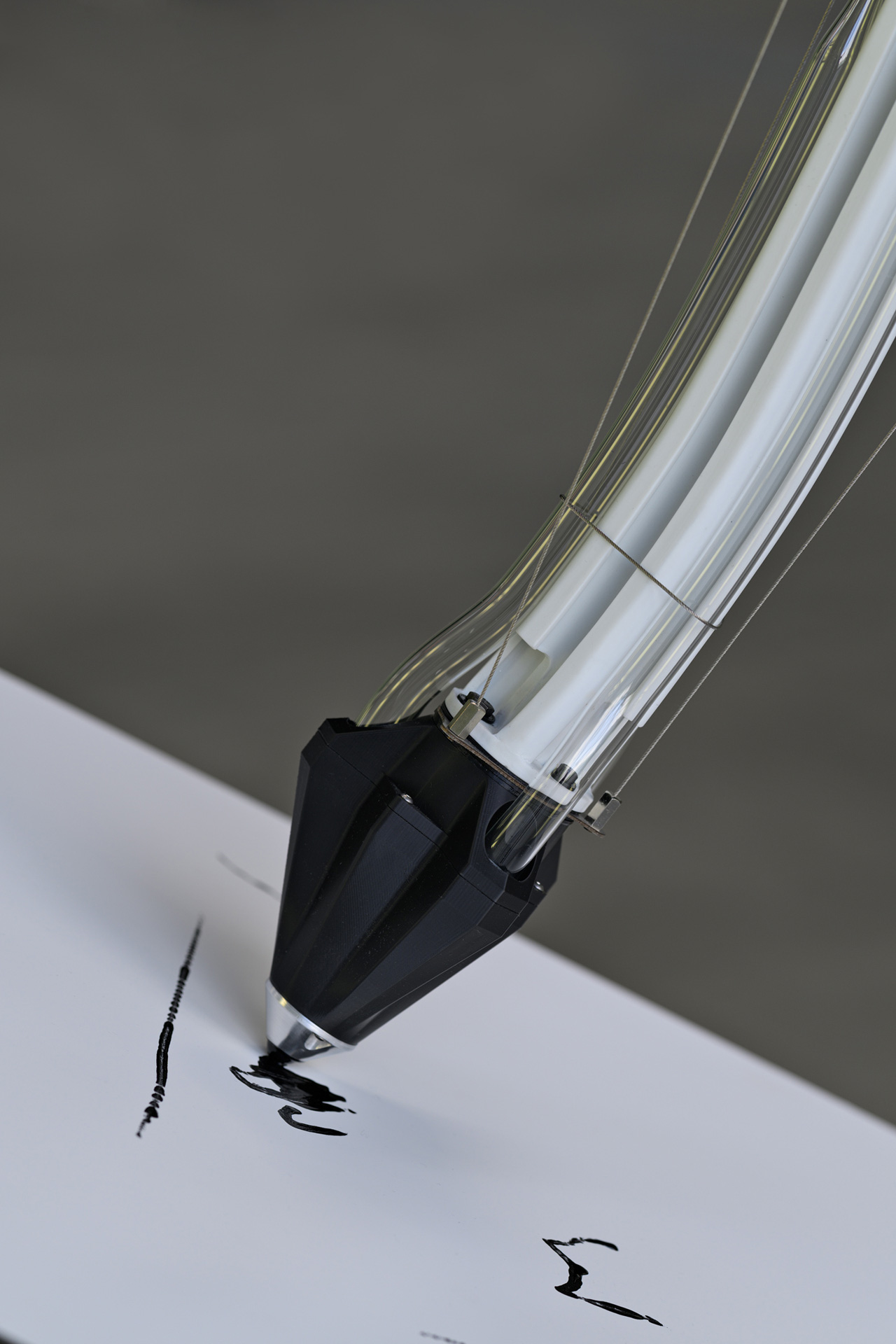
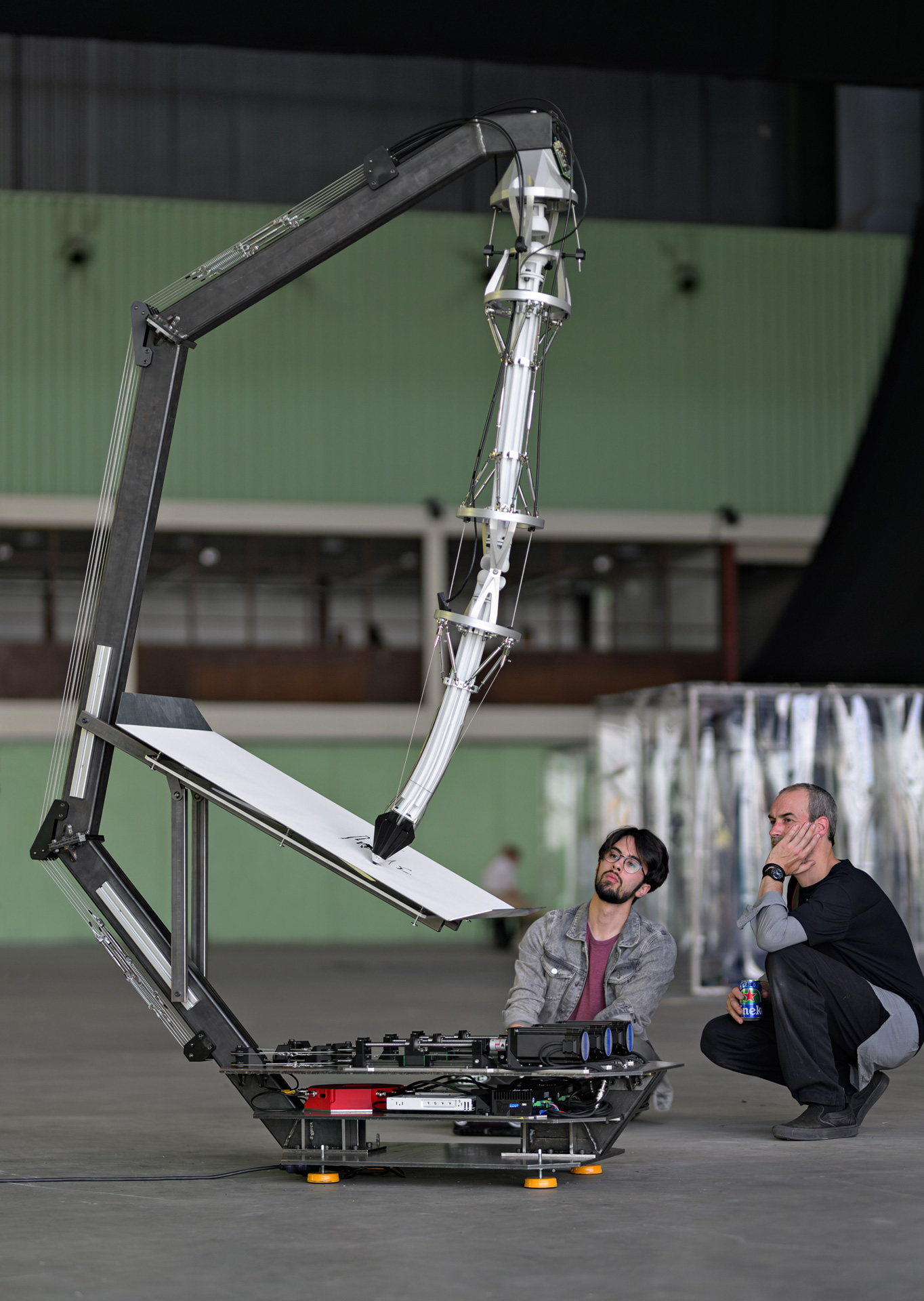

Performance Radical Drawing Device | Drawing installation | mechanics-electronics | 2019




[NL] De tekening van dan
April 2020 - Sven Schlijper-Karssenberg, kunstverzamelaar
Wat zie je voor je als je aan tekenen denkt? Papier, pen, misschien een potlood of een pot inkt. Je ziet vast geen flightcase voor je, met daarin een apparaat. Wanneer de Radical Drawing Device (RDD) tevoorschijn komt, lijkt het een complexe, maar tegelijkertijd opvallend eenduidige machine: een chromen 'kooi' met klemmen om deze te fixeren, een motor en een rails waarlangs een pen kan bewegen. De RDD is een autonome automaat bovendien, die de indruk wekt: “rustig maar... relax, ik kan het zelf wel aan”. De RDD kanaliseert kunstmatig artistieke intelligentie in een strak-helder design.
Maar de RDD is geen kille machine: ze treedt vanaf het moment dat ze tijdens een publieke performance uit de flightcase tevoorschijn wordt gehaald in dialoog met haar omgeving. Dat gesprek kent vele gezichten: van intens persoonlijk en intiem tot afstandelijk. Niet een vel papier, maar de kunstenaar is het canvas waarop de RDD tekent. Je ziet de pen en weet dat je gezien de naam radicaal tekenwerk kan verwachten van de RDD. Maar hoe wordt hiermee getekend? Wat tekent, en wat betekent dat? Deze basale aspecten van het tekenen bevraagt Jorrit Paaijmans met zijn RDD; ze liggen verankerd in de RDD.
De klemmen worden gesloten en de RDD zit vast om de arm van de kunstenaar. Het chroom glinstert. De pen blijkt een tatoeëernaald te zijn. Het fijne mechaniek van de RDD zet de naald in beweging; ze beweegt op en neer, diep in de huid. Verbijsterde en gebiologeerde blikken van toeschouwers alom. Op menselijke maat gemaakt, trekt de RDD met machinale ongevoeligheid een rechte lijn. De tatoeëernaald kent geen twijfel en gaat voort. De RDD tekent en betekent voor je oog - mechanisch en onuitwisbaar. De schoonheid ervan zit in het streven naar perfectie. Het afstellen, bijstellen, en herstellen van een machine die losgelaten kan worden en dan doet wat ze kan doen, wat ze moet doen.
Die ene lijn die voor altijd staat, werd nog verrassend snel gezet. Wat voorafging aan die lijn, ligt nu in zwarte inkt besloten en bestorven onder de huid. Hierin vangt Paaijmans - zoals kenmerkend is voor zijn werk - de filosofie van de tekenende mens, de getrokken lijn en de betekenis van mark makingals een centraal conversation piece. De lijn in het lijf, meegedragen voor altijd, is duidelijk gemarkeerd in visuele zin, maar kent een voorgeschiedenis en toekomst die veel minder helder vastgesteld kunnen worden. De huid is de plek van de uitwisseling van gedachte en uitvoering; theorie en praktijk. In het lichaam wordt de RDD-tekening als ademhalen, een sine qua non voor het dragende lichaam - zoals het papier dat bestaansrecht krijgt door de potloodtekening die erop wordt gezet.
Het kunstenaarschap van Paaijmans radicaliseert de wereld van het tekenen van binnenuit. Tekenaar, tekening en drager vormen een gesloten maar dynamische driehoeksverhouding - ook tussen dimensionele en fysieke of symbolische aspecten. De tekening is met de RDD meer, veel meer, dan een tekening alleen. De lijn herinnert aan een veelheid aan tekenende en betekenisvolle handelingen van de kunstenaar. Het publiek ziet slechts een deel. Misschien is de RDD in de toekomst verroest en vastgelopen. Misschien hebben we dan alleen de documentaire video of foto's nog. De lijn blijft, maar de lijn is niet het kunstwerk. En de RDD ook niet. Dat ligt elders. Misschien wel zoals Roni Horn zegt in gesprek met Theodora Vischer: “Niet zo overduidelijk of confronterend als een weerspiegeling, maar als een dubbeling, in de zin van een restant dat het verleden van het ding in herinnering roept en tegelijk het heden ervan actualiseert.”
De wereld en tijd voor de performance met de RDD, vóór het trekken van de lijn en die erna, vormen gezamenlijk het werk, zoals andere werken van Paaijmans niet gaan om de getoonde afbeelding, maar om het mechaniek waarmee ze worden opgehangen. En zoals het in het geval van zijn tekenmachines niet gaat om de lijn die door de machine voor je ogen getrokken wordt, maar om alles wat ervoor nodig is geweest om deze machine from scratch(an sich al: mark making) te bouwen. De machines en constructies van Paaijmans bevragen ook de tekening als markering in de tijd. Als je een bepaalde tijd doorbrengt bij een van zijn tekenmachines zie je een tekening die er al was voor je ogen veranderen. En je weet dat dat proces doorgaat.
Waar vallen die contingente afwegingen samen met die van de kunstenaar, en waar divergeren die juist van hem? Paaijmans noch zijn machines kiezen. En precies daar vindt Paaijmans nieuwe betekenis en plaats voor de tekening in onze tijd. Hij vindt de locus van het tekenen in de spanningsvolle speelruimte tussen maker en machine, de maker van de machine, en de machine als tekenaar. Het is maker noch machine die de tekenkeuzes maakt, maar het is wel Paaijmans die de voorwaarden schept. Die voorwaardelijke, inhoudelijke ruimte vol spanning maakt die ene lijn evenzeer voor altijd als maar een 'even'. Dat 'even' is bovendien zowel rechtlijnig als onbepaald. Elke lijn - en zeker deze ene lijn - is daarmee tegelijkertijd zichzelf en het spoor van zichzelf; een teken van zichzelf, van tijd en van het tekenen. Het is ook een lijn die samenvalt met de drager en het publiek; een lijn die betekenis achterlaat met myriaden gedachten voorwaarts, als souvenirs van de toekomst; als een tekening van dan.
![]()
April 2020 - Sven Schlijper-Karssenberg, kunstverzamelaar
Wat zie je voor je als je aan tekenen denkt? Papier, pen, misschien een potlood of een pot inkt. Je ziet vast geen flightcase voor je, met daarin een apparaat. Wanneer de Radical Drawing Device (RDD) tevoorschijn komt, lijkt het een complexe, maar tegelijkertijd opvallend eenduidige machine: een chromen 'kooi' met klemmen om deze te fixeren, een motor en een rails waarlangs een pen kan bewegen. De RDD is een autonome automaat bovendien, die de indruk wekt: “rustig maar... relax, ik kan het zelf wel aan”. De RDD kanaliseert kunstmatig artistieke intelligentie in een strak-helder design.
Maar de RDD is geen kille machine: ze treedt vanaf het moment dat ze tijdens een publieke performance uit de flightcase tevoorschijn wordt gehaald in dialoog met haar omgeving. Dat gesprek kent vele gezichten: van intens persoonlijk en intiem tot afstandelijk. Niet een vel papier, maar de kunstenaar is het canvas waarop de RDD tekent. Je ziet de pen en weet dat je gezien de naam radicaal tekenwerk kan verwachten van de RDD. Maar hoe wordt hiermee getekend? Wat tekent, en wat betekent dat? Deze basale aspecten van het tekenen bevraagt Jorrit Paaijmans met zijn RDD; ze liggen verankerd in de RDD.
De klemmen worden gesloten en de RDD zit vast om de arm van de kunstenaar. Het chroom glinstert. De pen blijkt een tatoeëernaald te zijn. Het fijne mechaniek van de RDD zet de naald in beweging; ze beweegt op en neer, diep in de huid. Verbijsterde en gebiologeerde blikken van toeschouwers alom. Op menselijke maat gemaakt, trekt de RDD met machinale ongevoeligheid een rechte lijn. De tatoeëernaald kent geen twijfel en gaat voort. De RDD tekent en betekent voor je oog - mechanisch en onuitwisbaar. De schoonheid ervan zit in het streven naar perfectie. Het afstellen, bijstellen, en herstellen van een machine die losgelaten kan worden en dan doet wat ze kan doen, wat ze moet doen.
Die ene lijn die voor altijd staat, werd nog verrassend snel gezet. Wat voorafging aan die lijn, ligt nu in zwarte inkt besloten en bestorven onder de huid. Hierin vangt Paaijmans - zoals kenmerkend is voor zijn werk - de filosofie van de tekenende mens, de getrokken lijn en de betekenis van mark makingals een centraal conversation piece. De lijn in het lijf, meegedragen voor altijd, is duidelijk gemarkeerd in visuele zin, maar kent een voorgeschiedenis en toekomst die veel minder helder vastgesteld kunnen worden. De huid is de plek van de uitwisseling van gedachte en uitvoering; theorie en praktijk. In het lichaam wordt de RDD-tekening als ademhalen, een sine qua non voor het dragende lichaam - zoals het papier dat bestaansrecht krijgt door de potloodtekening die erop wordt gezet.
Het kunstenaarschap van Paaijmans radicaliseert de wereld van het tekenen van binnenuit. Tekenaar, tekening en drager vormen een gesloten maar dynamische driehoeksverhouding - ook tussen dimensionele en fysieke of symbolische aspecten. De tekening is met de RDD meer, veel meer, dan een tekening alleen. De lijn herinnert aan een veelheid aan tekenende en betekenisvolle handelingen van de kunstenaar. Het publiek ziet slechts een deel. Misschien is de RDD in de toekomst verroest en vastgelopen. Misschien hebben we dan alleen de documentaire video of foto's nog. De lijn blijft, maar de lijn is niet het kunstwerk. En de RDD ook niet. Dat ligt elders. Misschien wel zoals Roni Horn zegt in gesprek met Theodora Vischer: “Niet zo overduidelijk of confronterend als een weerspiegeling, maar als een dubbeling, in de zin van een restant dat het verleden van het ding in herinnering roept en tegelijk het heden ervan actualiseert.”
De wereld en tijd voor de performance met de RDD, vóór het trekken van de lijn en die erna, vormen gezamenlijk het werk, zoals andere werken van Paaijmans niet gaan om de getoonde afbeelding, maar om het mechaniek waarmee ze worden opgehangen. En zoals het in het geval van zijn tekenmachines niet gaat om de lijn die door de machine voor je ogen getrokken wordt, maar om alles wat ervoor nodig is geweest om deze machine from scratch(an sich al: mark making) te bouwen. De machines en constructies van Paaijmans bevragen ook de tekening als markering in de tijd. Als je een bepaalde tijd doorbrengt bij een van zijn tekenmachines zie je een tekening die er al was voor je ogen veranderen. En je weet dat dat proces doorgaat.
Waar vallen die contingente afwegingen samen met die van de kunstenaar, en waar divergeren die juist van hem? Paaijmans noch zijn machines kiezen. En precies daar vindt Paaijmans nieuwe betekenis en plaats voor de tekening in onze tijd. Hij vindt de locus van het tekenen in de spanningsvolle speelruimte tussen maker en machine, de maker van de machine, en de machine als tekenaar. Het is maker noch machine die de tekenkeuzes maakt, maar het is wel Paaijmans die de voorwaarden schept. Die voorwaardelijke, inhoudelijke ruimte vol spanning maakt die ene lijn evenzeer voor altijd als maar een 'even'. Dat 'even' is bovendien zowel rechtlijnig als onbepaald. Elke lijn - en zeker deze ene lijn - is daarmee tegelijkertijd zichzelf en het spoor van zichzelf; een teken van zichzelf, van tijd en van het tekenen. Het is ook een lijn die samenvalt met de drager en het publiek; een lijn die betekenis achterlaat met myriaden gedachten voorwaarts, als souvenirs van de toekomst; als een tekening van dan.
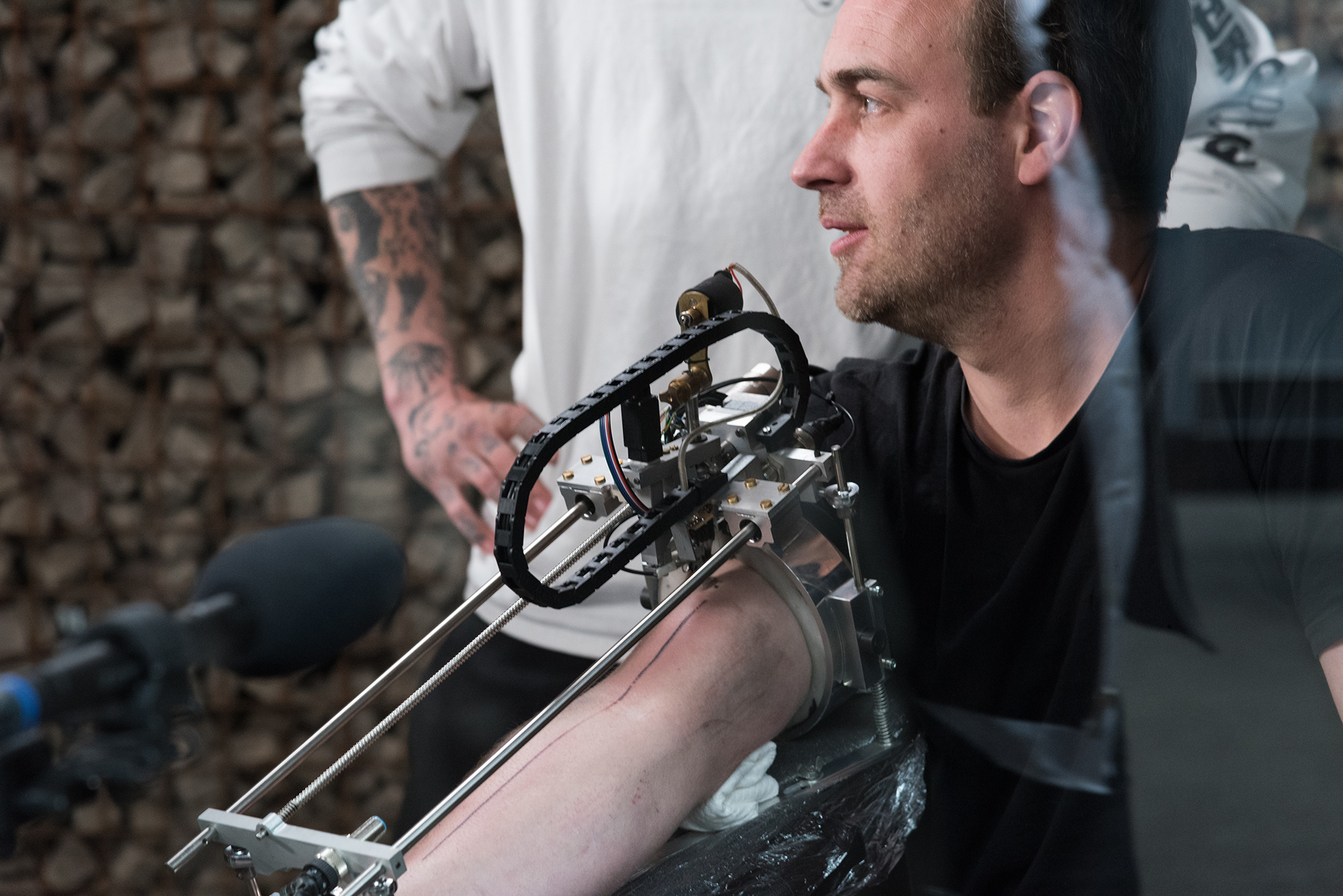
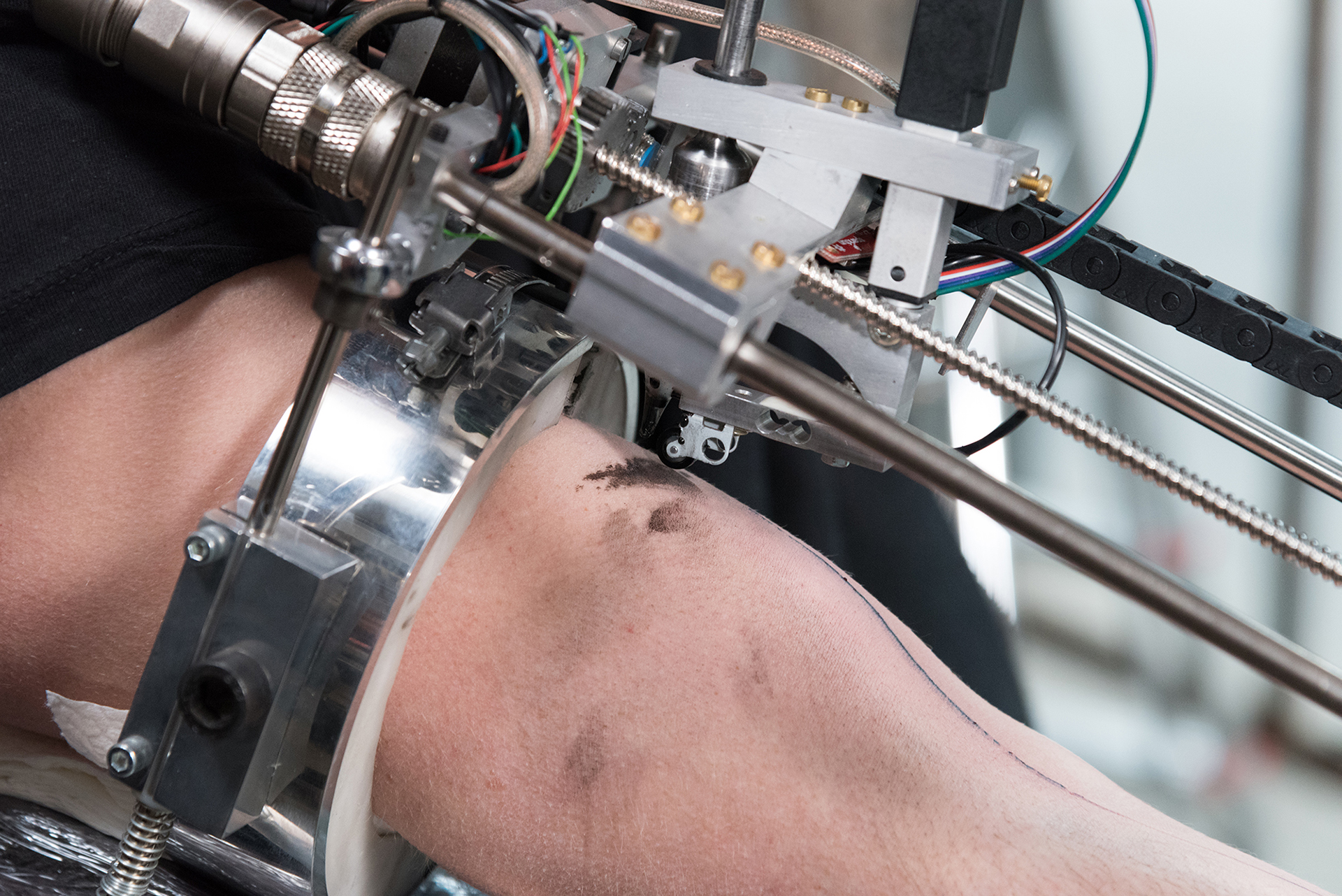
[ENG] The drawing from then
April 2020 - Sven Schlijper-Karssenberg, artcollector
What do you see when you think of drawing? A piece of paper, a pen, perhaps a pencil or an ink bottle. You probably don’t imagine a flight case containing a device. When the Radical Drawing Device (RDD) is taken out of its box, it appears to be a complex, yet clearly purpose-built device: a chrome ‘cage’ with clamps to attach it, a motor, and rails that guide a pen. Moreover, the RDD is an autonomous machine that radiates the sentiment: ‘calm down... relax, I can handle it myself’. With its sleek, streamlined design, the RDD impersonates artistic intelligence in an artificial way.
However, the RDD is not a cold-blooded contraption: when it is taken out of the flight case during a public performance, it immediately enters into dialogue with its environment. This conversation has many facets: from intensely personal and intimate to distant. It’s not a piece of paper, but the artist himself that is the canvas on which the RDD will draw. You see the pen, and, given the RDD’s name, you can expect a radical act of drawing. But just exactly how does it draw? What draws, and what does that mean? Jorrit Paaijmans questions the core elements of drawing with his RDD; they are anchored in the RDD.
Clamps are used to attach the RDD to the artist’s arm. The chrome shimmers. The pen turns out to be a tattoo needle. The precise mechanism of the RDD sets the needle in motion; it moves up and down, penetrating the skin. The viewers look on, bewildered and mesmerised. Designed to human proportions, the RDD draws a straight line with mechanical detachment. The tattoo needle never wavers and draws continuously. Before your very eyes, the RDD scribes and ascribes meaning, both mechanically and indelibly. Its beauty lies in the pursuit of perfection. The machine is constantly being adjusted, fine tuned and maintained to ultimately be unleashed to do what it can do, what it has to do.
For a line that would last forever, it was drawnsurprisingly quickly. In the blink of an eye, all that preceded the line is captured and sealed under the skin in black ink. As is characteristic of his work, Paaijmans touches upon the philosophy of the drawing human, the drawn line, and the meaning of mark-making as a central conversation piece. The permanently embodied line, so clearly defined visually, has a history and future that are much less clear. The skin is the place of exchange between idea and execution, between theory and practice. For the body, the RDD drawing is like breathing, a sine qua nonfor the host – like a piece of paper whose only raison d'êtreis the image that is drawn on it .
With his artistic practice, Paaijmans radicalises the world of drawing from within. Draftsman, drawing and carrier form a closed but dynamic triangular relationship, also between dimensional, physical and symbolic aspects. With the RDD, the drawing is more, much more, than merely a drawing. The line recalls a multitude of illustrative and meaningful acts by the artist. The audience only sees part of it. Perhaps in the future the RDD itself will be rusty and jammed. Perhaps the documentary video or photos will survive.The line will remain, but the line is not the artwork. Nor is the RDD. It is something else. Perhaps as Roni Horn says in conversation with Theodora Vischer: ‘Not as obvious or confrontational as a reflection but a double in the sense of a trace that recalls the past of the thing at the same as manifesting its present.’
The world and time before the RDD performance, before the line was drawn, and the time thereafter, collectively form the artwork. It displays similarities with other works by Paaijmans that are not about the image, but about their mechanism. In the case of the drawing machine, the line it draws in front of your eyes is not the core of the work; the core lies in everything it took to build the machine from scratch. Paaijmans’ machines and constructions also question drawing as a mark in time. If you spend some time with one of his drawing machines, you will see an existing drawing change in front of your eyes. And you know that process will continue endlessly.
Where do these contingent considerations coincide with those of the artist, and where do they diverge? Neither Paaijmans nor his machines choose. It is precisely here that Paaijmans finds a new meaning and a new place for the concept of drawing today. He finds the locus of drawing in the exciting and playful tension between maker and machine, the maker of the machine, and the machine as a draftsman. It is neither the maker nor the machine that makes the choices, but it is Paaijmans who creates the conditions. That conditional, substantive space full of tension makes that one line as permanent as much it makes it ephemeral: a blink of an eye that is straightforward and undefined. Each line – and certainly this particular line – is therefore itself and the trace of itself at the same time, a trace of itself, of time and of drawing. It is also a line that coincides with the artist and his audience; a line that leaves meaning behind with myriads of forward-projecting thoughts, as souvenirs of the future: as a drawing from ‘then’.
Body #1 | Sculptural Drawing | Wood-climbing rope-steel-LED-Electronics | 2019 [total lenght] 15 meter
![]()
![]()
![]()
![]()
![]()
![]()
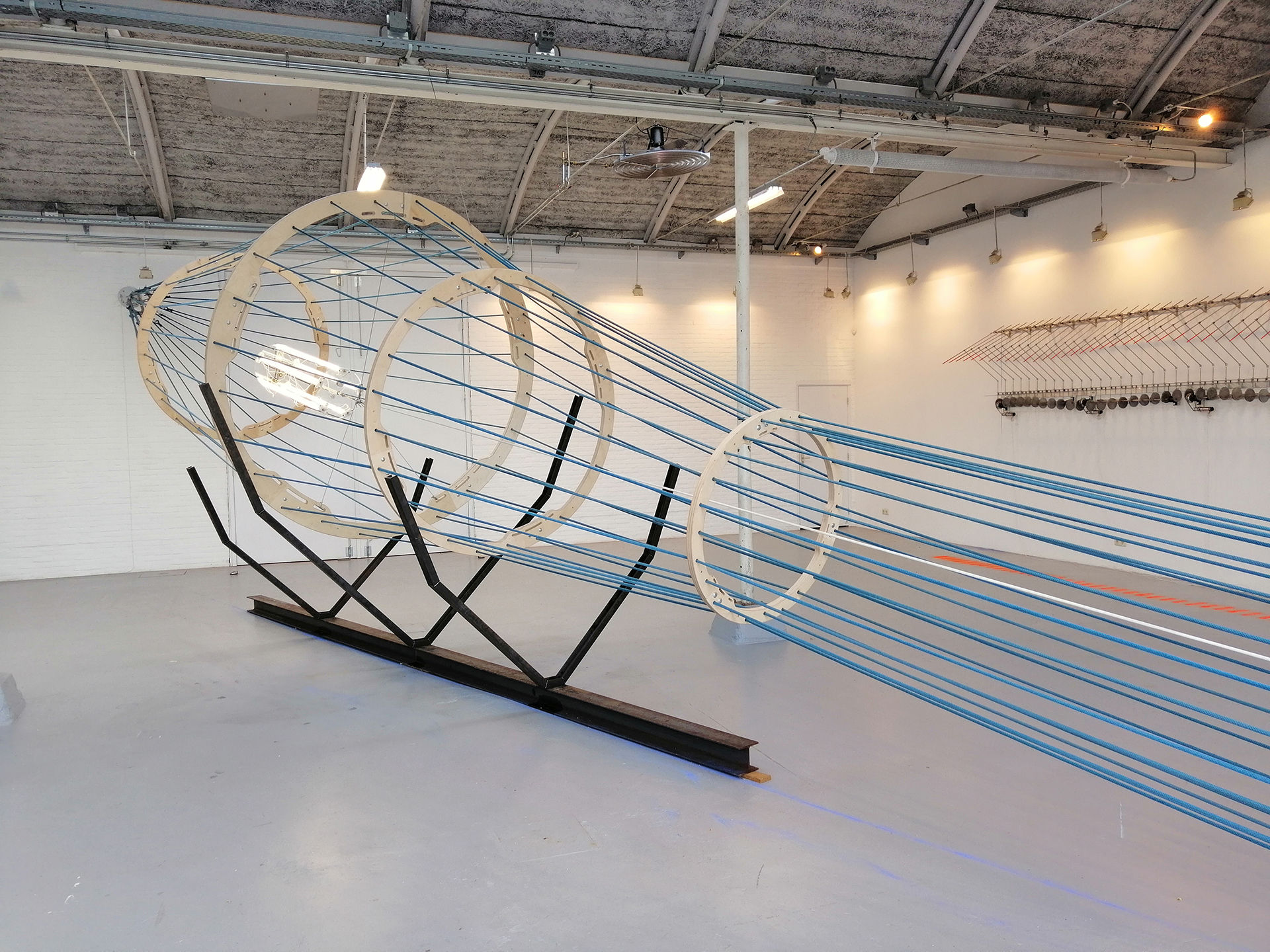

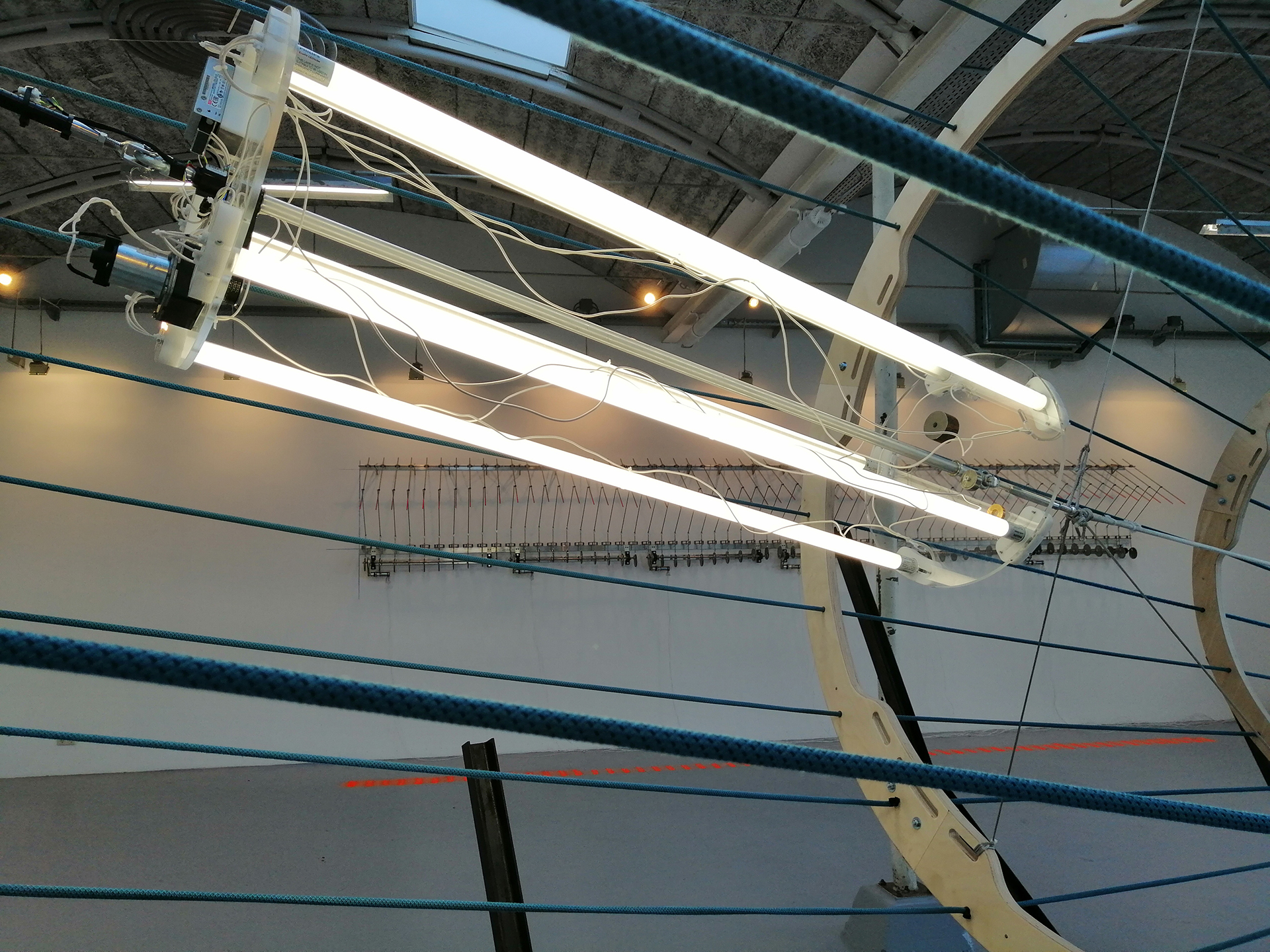

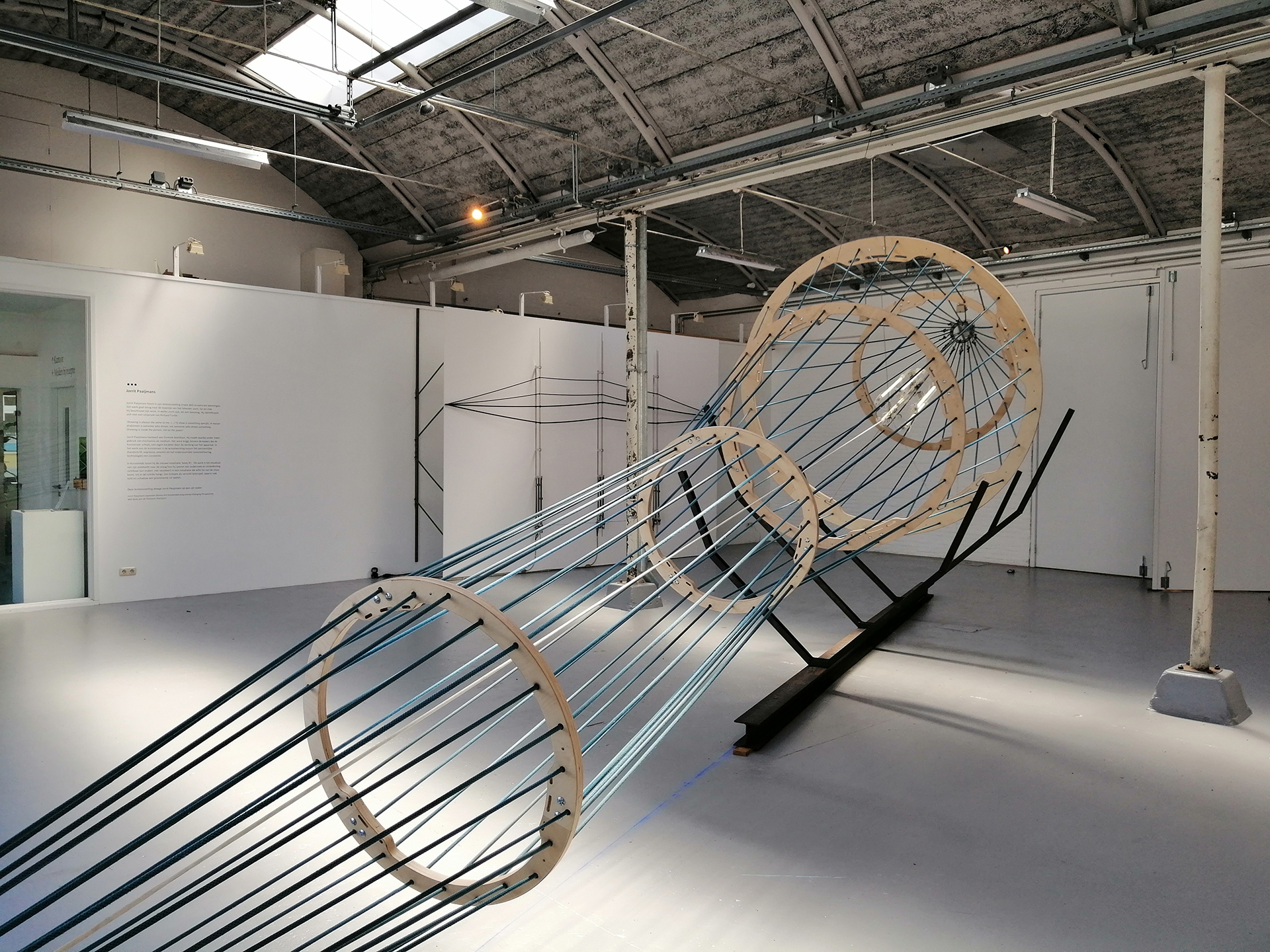

Fluctus No.1 | Kinetic Installation | Mechanics-Electronics | 2018 [total lenght] 12 meter



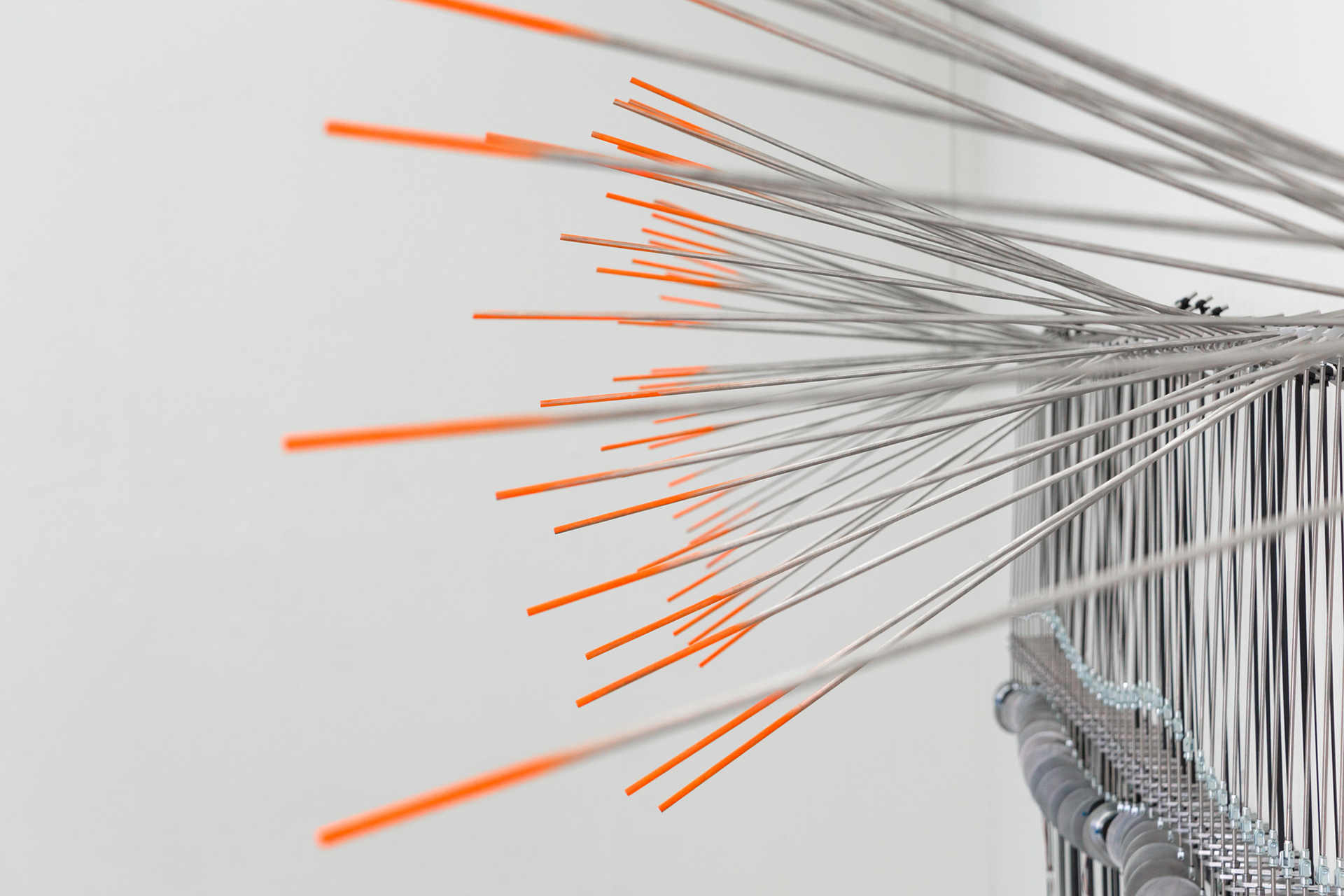




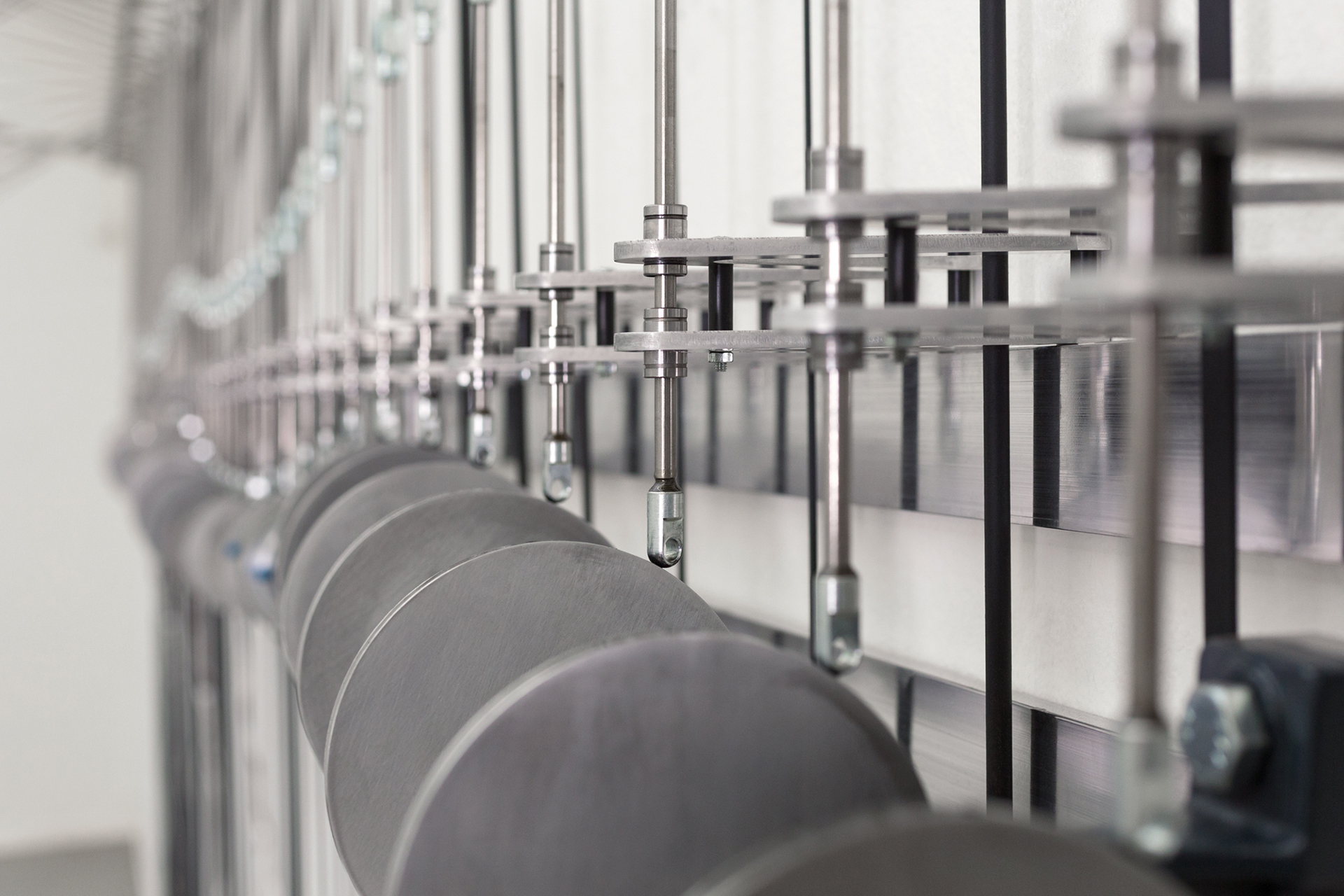
Linearis Objectum No.3 | Kinetic Installation | Mechanics-Electronics | 2024 [total lenght] 3,5 meter
![]()
![]()
![]()
